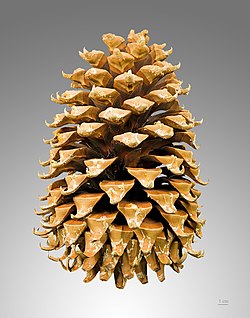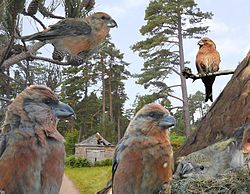Crossbill
The crossbills are a genus, Loxia, of birds in the finch family (Fringillidae). There are three to five (or possibly many more) species.
| Crossbill | |
|---|---|

| |
| Red crossbill or common crossbill (Loxia curvirostra) | |
| Scientific classification | |
| Unrecognized taxon (fix): | Loxia |
| Type species | |
| Loxia curvirostra | |
| Species | |
|
Loxia pytyopsittacus | |


These birds have mandibles with crossed tips, which gives the group its English name.[1] Adult males tend to be red or orange in colour, and females green or yellow, but there is much variation.
Crossbills are specialist feeders on conifer cones. The unusual bill shape is an adaptation to get seeds from cones. These birds are typically found in higher northern hemisphere latitudes, where their food sources grow. They move ("erupt") out of the breeding range if the cone crop fails. Crossbills breed very early in the year, often in winter months. This is the time to get the most cones.
They put their beak slightly open between the scales of conifer cones. Then they close their beaks and the tips push the scales apart. This lets them get at the seed (usually two seeds per scale). The point is that, as cones mature, they tend to open when dry and close when wet. Eventually they fall, and lie on the ground. As they dry the scales naturally open, and any animal can get at the seeds. With their beaks, crossbills can get at the seeds much earlier than any other animal.
Food preferences
Each species' bill shape is optimised for opening seeds from different species of conifer.[1] Their preferred food sources are:
- Parrot crossbill, Loxia pytyopsittacus
- Scots pine Pinus sylvestris
- Scottish crossbill, Loxia scotica (formerly treated as a race of parrot crossbill)
- Scots pine Pinus sylvestris and Larch Larix species (particularly plantations of L. decidua)
- Red crossbill or common crossbill, Loxia curvirostra
- Spruce Picea species; some populations (distinct species?) on various pine Pinus species and (in western North America) Douglas-fir
- Two-barred crossbill or white-winged crossbill, Loxia leucoptera
- Hispaniolan crossbill, Loxia megaplaga (previously treated as a race of two-barred crossbill)
- Hispaniolan pine Pinus occidentalis
The relationships between crossbill species has been much studied.[2]
Crossbill Media
Red crossbill skull and jaw anatomy from William Yarrell's A History of British Birds (1843)






